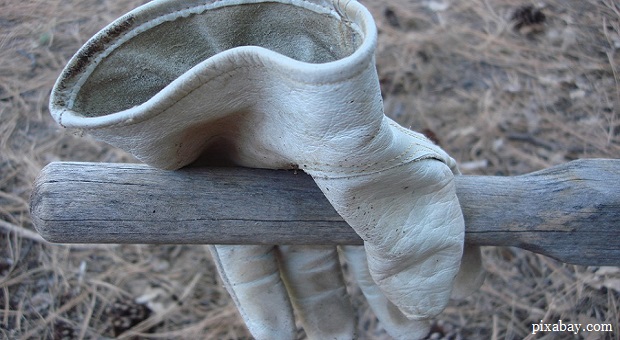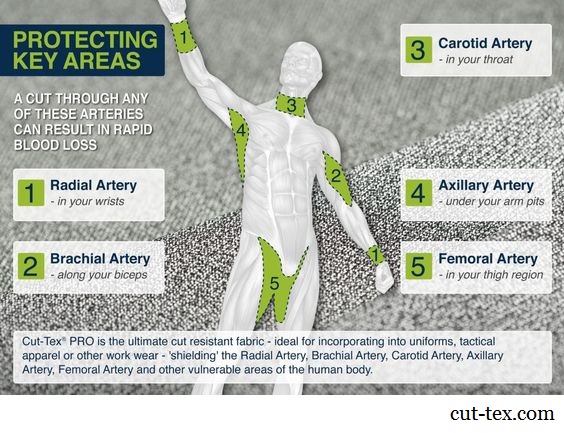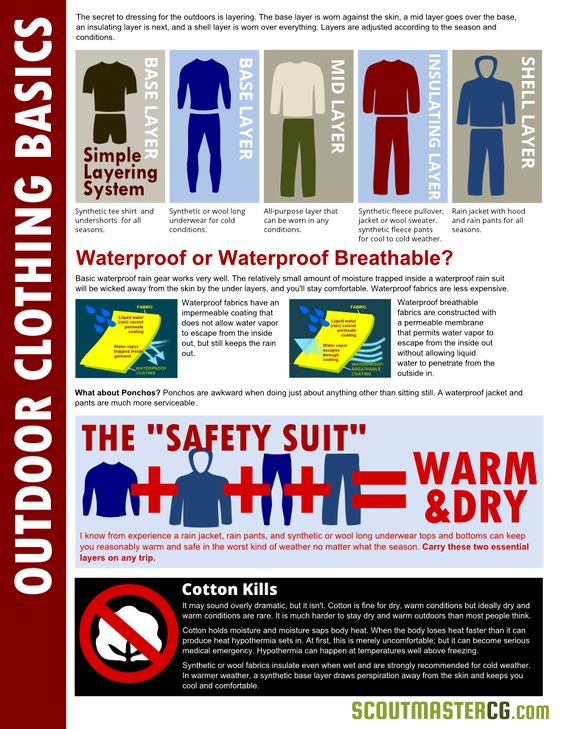Whether you are planning to go camping, do some yard work, or live outdoors, you’ll need appropriate clothing.
From extreme temperatures to injuries, health risks, and even dangers posed by other people, these specific fabrics and garment will keep you safe. Contrary to popular belief, you do not need to buy new clothes or even ones that are pre-made, and stockpile them for a crisis situation.
Focus on these 10 questions about material and fit, and you can easily find good quality clothing that will remain in good condition over time.
Is It Easy to Wear in Layers?
If you are expecting to be outdoors in cold weather, it is very tempting to look for the thickest, heaviest garments that you can find. While a certain amount of density in the fabric is important, the ability to have air spaces is also vital for retaining heat.
Choosing thinner garments that you can wear in layers creates air space, and also gives you a greater range of temperatures that you can feel comfortable in.
When choosing garments for layering, you must also pay attention to the garment size and how easy it will be to shift it comfortably between layers, or eliminate altogether.
You may need to buy a ½ to a full size bigger as you reach the outer layers. If at all possible, see if you can try on all the layers at once to see if they feel comfortable and don’t limit your range of motion.
Does the Fabric Wick Well?
No matter what the temperature and humidity conditions are, your body is going to release sweat. If you are active and moving around a lot, your body will release even more sweat in order to cool down.
A buildup of moisture next to your skin can cause several problems including:
- an increased risk of skin breakdown, especially in areas where garments rub into your skin
- an increased risk of infection in any are where the outer layer of skin has been compromised
- because your body produces sweat in order to cool down, you may lose vital heat if too much moisture stays near your skin. Even if you are in very cold temperatures, the sweat your body produces will cause this cooling effect and spell disaster. Fabrics that wick away moisture will help keep your core body temperature stable.
Will the Fabric Resist Tearing?
You might be going through dense underbrush, or areas where there are apt to be thorns that would scratch your skin if your garments didn’t protect you properly.
A scratch from a thorn or a shrub branch may not seem like more than an inconvenience, but your skin can infect if left unattended. This is especially important if you’re traveling through damp areas or other places where mold, bacteria, mildew, and other pathogens can be introduced into the opening in your skin.
To add insult to injury, if your clothes do not wick correctly, or are uncomfortable to wear, these problems can also make the skin wound even worse.
Choose at least one outer layer garment that is as tear resistant as possible, to prevent this kind of problems. Look for lightweight clothes that are designed to be worn outdoors and a name brand that have a good reputation for producing tear free garments.
Remember, even if you cannot afford new garments, it is not all that difficult to create a loose fitting shirt and pants from suitable material. You may also be very surprised at what you will find at estate sales, yard sales, and flea markets.
How Will the Colors Affect Heat Absorption?
You know that white blocks energy and black absorbs, but you may not give it much though when choosing clothes for outdoor wear. If you are going to be out in colder weather, have an outer layer garment that is black or some other dark color.
On the other hand, if you expect to be out in warmer or hot weather, wear something white or light colored. Bright colors will also absorb heat from the sun, so it is best to reserve them for cooler or mid-range temperatures.
When you are planning an outdoor excursion, make sure you have at least one white, one black, and one neutral color so that you can switch them on and off as needed for your outer garment layers.
Also, if you need different sizes for the inner layers, take along at least one white garment so you can wear it as a single inner layer if you happen to be in hotter temperatures and need to remove all but one layer.
Choose a garment that has long sleeves or legs so that you can still protect yourself from injuries created by thorns, underbrush, or insects.
Can I Adjust the Visibility of this Garment?
Regardless of whether you hunt or not, you may be at risk of being shot or injured in the woods if you aren’t aware of where people are hunting.
You may also come across intentional poachers or those who are hunting out of extreme need outside of legally defined hunting seasons. That’s why it’s best to wear clothes that will ensure you are easy to see and that you will also not be mistaken for game.
Typically, blaze orange is the best color for wearing in an area where hunting will occur because it will not be as easily mistaken for colors found on certain animals.
On the other hand, you might need to escape from a city during crisis or prefer other people be unable to spot you. In these situations, wearing blaze colors, or even white might spell disaster. If your prime concern is visibility, wear a neutral color for the terrain you are traveling through.
For example, you might choose a dark green for the woods, or a tan for desert terrain. If you find that you want to be seen easily, then carry blaze orange arm bands, patches, scarfs, or other coverings that you can easily affix to any outer garment.
What Temperature Ranges is it Best Worn in?
Many people think that layering garments means you can simply wear the same garments all year round, but just add or subtract layers as needed. This won’t always work because different fabrics have different densities to their weaving that make them suitable for some temperatures and not others.
Pay attention to the fabric type and density so that you know which garments may work better for the season. You can still keep one or two items on hand that will fit a mid range, however the rest should be divided between materials suitable for hot or colder temperatures.
Here are some common fabrics and the temperatures they will work best in:
- Linen – hot weather – this fabric breathes and wicks well, dries fast, and is also lightweight.
- Cotton – depends on the weight. Lighter weight cotton can be used for summer and hot weather, and then use heavier weights for mid range temperatures. Never use cotton for cold weather or any temperature where you must preserve core body temperature because it sucks up sweat easily and will pull heat from your body with the sweat.
- Polyester – cold weather – use for inner layers to build air spaces. This fabric does not breathe well, so try to keep it away from your skin.
- Wool – cold weather. Is a good insulator and also dries quickly.
- Nylon – use as an outer layer for keeping dry and as a wind breaker. Nylon also doesn’t breathe well and should be reserved for outer layers that can be opened up easily to improve air circulation.
Is it Waterproof?
Aside from needing to find out if an outer layer of clothing will withstand rain and other forms of moisture, you have to evaluate the same information for inner layers of outdoor clothing.
While you will want at least one garment to wear when it rains or you need to keep excess moisture out, it will not be a good idea to have waterproof material on any of the inner layers of your outdoor clothing.
Typically, waterproof garments do not wick well, and they will also prevent moisture that has been released by your skin from escaping, which can cause hypothermia in cold weather, and increase the risk of infections because of poor air circulation.
Does it Cover Me Properly for Woods and Rough Terrain?
Have you ever been outdoors in hot weather and didn’t even want to wear a T-shirt? If so, then you may also be tempted to wear the lightest and skimpiest thing you can find to go in the woods.
Unfortunately, this can be a recipe for disaster because:
- As you travel through underbrush, you will inevitably brush into brambles, thorns, and twigs. These can easily cut your skin and leave an opening for infection.
- Ticks, mosquitoes, and other insects are drawn to anything that might look like a meal. In this case, they can easily land on the back of your neck, upper leg, or other areas where you won’t notice them until it’s too late. The best way to prevent Lyme disease and many other insect borne illnesses it make sure the bugs can’t land on your skin to begin with. Insofar as clothing choice, your best option is to wear garments that cover as much of your skin as possible.
- Many people think they can just spray insect repellent on their skin and clothing, and then avoid wearing clothes that cover their skin. These sprays are expensive and exposing you to dangerous poisons that can have long term health consequences, are not likely to be available in the post crisis world. Choose and wear clothes that will cover your skin properly now so that you won’t have to adapt later on.
Can I Adjust the Garment to Keep Out Ticks and Other Insects?
Aside from choosing garments with long sleeves and legs, make sure you can use rubber bands, velcro, or something else to seal off sleeve and pants cuffs.
Add a lightweight turtleneck stop shell in order to prevent insects from landing on the back of your neck. If you cannot find one for sale in a suitable fabric, you will find they are very easy to make.
Make sure they are properly secured and sealed to the garment below them so insects cannot crawl in.
How Well Will it Protect from UV Radiation?
Are you the type that packs the sunscreen away as soon as summertime is over? If so, then you need to use fabrics that have a proven SPF rating for outer layer wear all year round. As long as there is sunlight available, UV rays can reach your skin and cause damage. Even if it is a cloudy day or a very cold one, it is important to wear UV proof clothing.
Contrary to popular belief, fabric garments will not automatically block out all UV. To perform a quick test, hold the fabric up to the light. If you can see any light at all shining through, then the garment will allow UV to reach your skin.
Since you will be buying lighter weight garments to create layers, this test is extremely important all year round. To be on the safe side, choose at least one outer layer garment from a reputable company that gives an SPF rating on the label.
As with choosing garments that can be adjusted for keeping insects away, choosing garments that protect your skin from UV can help in a major social collapse scenario. Why worry about buying sunscreen when you can use these garments to do the same job. You can increase the lifespan of your sunscreen stockpile until you figure out a way to make your own using natural materials.
If you visit any department store or mall, you will find all kinds of expensive “outdoor” gear, and find yourself wondering what to buy. Try starting off with lighter weight garments that can be worn in layers, and then focus on color, visibility, waterproofing, UV protection, and insect management.
Asking ten simple questions about each garment, and thinking about how you will use it, will also help you evaluate garments in other places.
No matter whether you visit a second hand store, flea market, or decide to sew the garments, you will have confidence in evaluating the garment and fabric within the context of your needs as opposed to always relying on name brands and testimonials.
This article has been written by Carmela Tyrell for Survivopedia.










Bill in Idaho | August 30, 2017
|
W O W, Carmela T., this Article is a Jewel – I Am Serious. You Covered the Essentials Very Well ! Concerning “Nylon” – I don’t use it at all – Heavy (16 Oz.+) Sailcloth (aka Cotton Duck, aka Heavy Denim) will hold up and remain Very Tough and Durable, if given a Sealant and kept fairly clean. Other than that, I Agree with You 100%. Great Work – Take Care. Bill